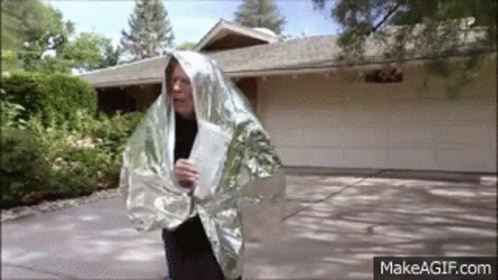The Sapienza computer scientists say Wi-Fi signals offer superior surveillance potential compared to cameras because they’re not affected by light conditions, can penetrate walls and other obstacles, and they’re more privacy-preserving than visual images.
[…] The Rome-based researchers who proposed WhoFi claim their technique makes accurate matches on the public NTU-Fi dataset up to 95.5 percent of the time when the deep neural network uses the transformer encoding architecture.
you can also take a picture of a person with a camera that senses light beams
The most primitive of physics concepts, the transmission/absorption/reflection of energy, is completely unknown to most people it would seem.
95.5% accuracy is abysmal for any use case these people want to use it for
what if you combine it with other types of imaging
Dingdingding
Time to start making faraday clothes.
With wild and crazy shape lines. Ultra futuristic fashion here we come!
Reminds me of the Christian Bale batman movie where he could spy on everywhere from the bat cave. Seemed so far fetched it almost ruined the movie
No-one suspected Bruce Wayne’s “free WiFi for Gotham City” initiative
This shits already used by xfinity
Well, that’s quite different, it didn’t identify anyone
Wait… so the guys with tinfoil hats were on to something?
And this here folks is the true ending. No one there is going to stop it as always.
Congratulations! You are now fully fucked!
There is the draft dodger, he is located in building #52556 in this city, info updated 125 milliseconds ago. He left his phone at his house 5 states away, go get him.
Well of course the Sapienza scientists would figure this out, Agent 47 keeps killing everyone in the labs
Time to carry a WiFi jammer
The resulting image must just basically look like a shadow, I can’t imagine that they’re going to get much internal detail with Wi-Fi considering that my router’s signal practically gets blocked by a piece of cardboard.
This research essentially amounts to, humans can be individually identified with nothing more than low quality x-rays. Well yeah, so what, you can also use visible light and in any situation where you’re going to use Wi-Fi to detect someone, it’s got to be easier to buy a cheap CCTV camera.
They explicitly went into the advantages over cameras:
- Any light condition (of course IR lighting with IR cameras are the gold standard so this can argueably be met otherwise)
- The ability to cover multiple rooms through walls with a device. A sub-10 GHz signal can penetrate most interior walls. People could be tracked without even being able to see a camera and by extension not knowing where to mess with to defeat surveillance.
So perhaps a building takes a picture of everyone as they come in the front door and also establishes a ‘WhoFi’ profile for that person. They could keep track of their movement through the building while maintaining an actionable correlation to a photo.
First of all: cardboard does NOT block electromagnetic waves. You need a Faraday Cage for that. And even then, it has to have holes of a certain size to block specific wavelengths/frequencies. It’s why you have a mesh on the door of your microwave for example.
Secondly: they’re not attempting to photograph you. Just identifying your unique signature once would allow them to track your location anywhere where they have the gear installed.
Given your in-depth knowledge of Wi-Fi to consider it blocked by cardboard, I somehow doubt the rest of this comment is credible…
When they send a drone to your house they can make sure exactly where you are so they can shoot you through the wall.
Stilsuits: get it for the unbearable heat as we turn the Earth into a desert, now with wifi blocking!

Chuck vindicated. What a chicanery.
I’m generally pro research, but occasionally I come across a body of research and wish I could just shut down what they’re doing and rewind the clock to before that started.
There is no benefit of this for the common person. There is no end user need or product for being able to identify individuals based on their interactions with WiFi signals. The only people that benefit from this are large corporations and governments and that’s from them turning it on you.
Continued research will ease widespread surveillance and mass tracking. That’s not a good thing.
First - someone comes up with this. Next, privacy researchers and black/white/grey hat techies come up with methods to defeat it.
Better for surveillance tech research like this to be published out in the open than developed in some secret lab. I figure these researchers are doing more positive than negative by publishing their findings. It’s not like if they didn’t publish, someone else wouldn’t come up with this and possibly use it clandestinely.
Could be developed into a useful tool for search and rescue
Probably not.
This kind of thing relies on the fact that the emitter and environments are static, impacting the propagation of the signals in a predictable way and that each person, having a unique physique, consistently interferes with that propagation in the same way. It’s a tool that reports “the interference in this room looks like the same interference observed in these past cases.”
Search and rescue is a very dynamic environment, with no opportunity to establish a local baseline, and with a high likelihood that the physiological signal you are looking for has been altered (such as by broken or severed limbs).
There are some other WiFi sniffing technologies that might be more useful for S&R such as movement detection, but I’m not sure if that will work as well when the broadcaster is outside the environment (as the more rubble between the emitter and the target the weaker your signal from reflections against the rubble).
Don’t think of this as being able to see through walls like with a futuristic camera, think of this as AI assisted anomaly detection in signal processing (which is exactly what the researchers are doing).
Microwave based ground penetrating radar is actually different from WiFi. Also the technology referenced in the link is a motion based body locator, not an identity recognition device.
This is different technology doing different things than what the original article was talking about.
You are correct because something similar has already been used
https://spinoff.nasa.gov/FINDER-Finds-Its-Way-into-Rescuers-Toolkits
Microwaves are the same as wifi waves, these are able to detect bodies and whether the bodies are beating or not
WiFi uses a subset of the significantly wider microwave band. Ground Penetrating Radar also uses a subset of the microwave band. While there can be some overlap, the frequencies desired for GPR will very broadly based on what you are looking for, what you are looking in, and how deep you are looking for that thing. The wattage supplied can also differ.
WiFi and Microwaves in general are most definitely not the same thing and I will absolutely encourage you to not set up a 1kW 3GHz jamming antenna for your WiFi needs.
Could you use WiFi for search and rescue? Maybe for a narrow set of circumstances, but in almost all situations a dedicated GPR option will be better.
This also won’t identify a victim, only revealing that one exists.
It is cool for home automation if you can turn it into a presence detection software (do not connect your Homeassistant to the internet though)
If all you need is presence detection then a motion sensor would be vastly more efficient.
If you actually need identity detection, then maybe, but you’ll still have to have a camera or detailed access logs to associate the interference signature with a known entity and at that point you may as well just put an RFID reader under the bowl you throw your keys into or use facial or gait detection.
A motion detector is far more inferior to precense detectors, most just use milimator wave though.
Great, another dystopian way for authorities to observe me on the shitter
accurate matches up to 95.5% of the time
and they’re more privacy-preserving than visual images
Oh fuck all the way off.
When anyone or anything says that their product works “up to x%” I always presume it doesn’t really work at all.
Christ, 1% is included in that “up to 95.5%” vague bullshit statement.I hate it when commercials say “up to 100%.” It’s literally a pointless metric; that could mean anything from 0% to 100%, inclusive.
edit: Closed quote.
Sounds like an ad tailored specifically to putin
My thought exactly. Their definition of privacy is… interesting






